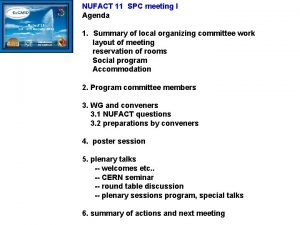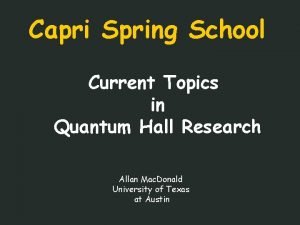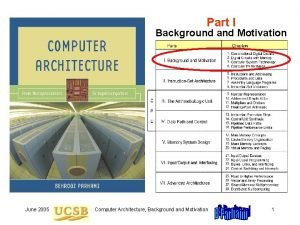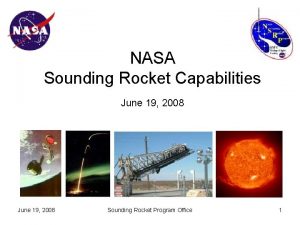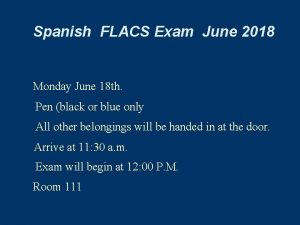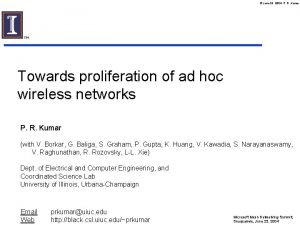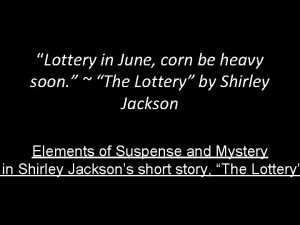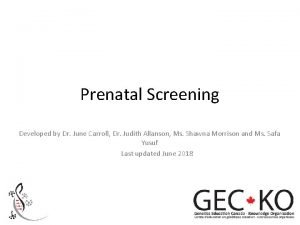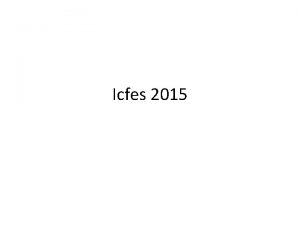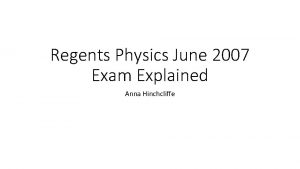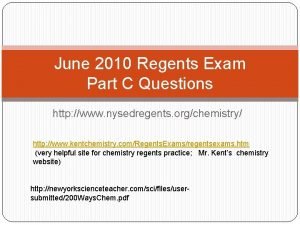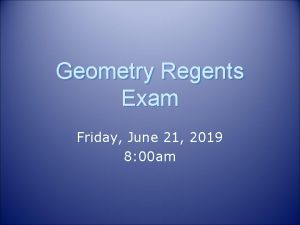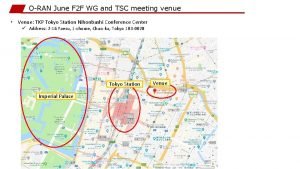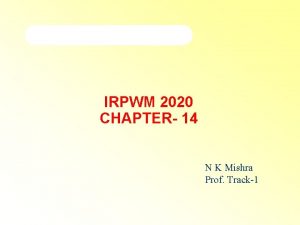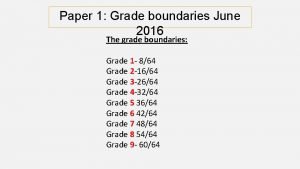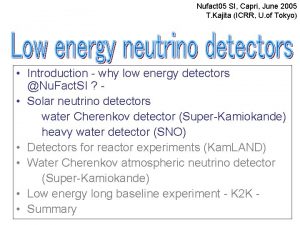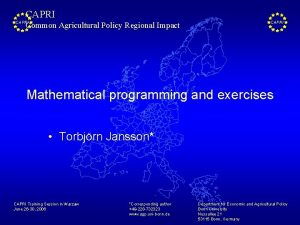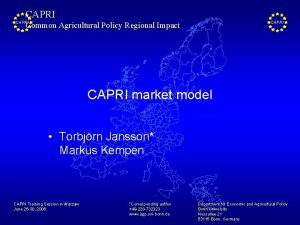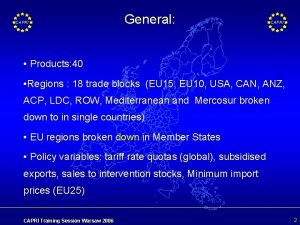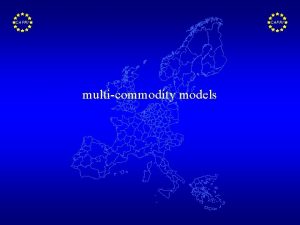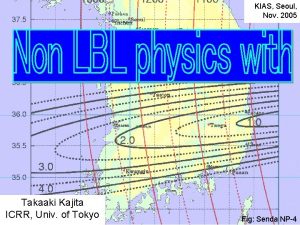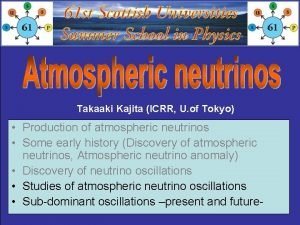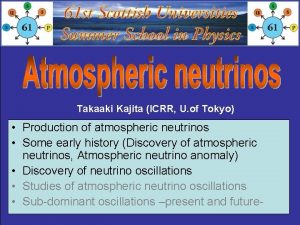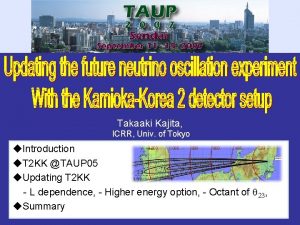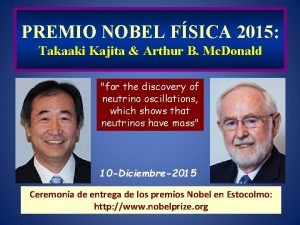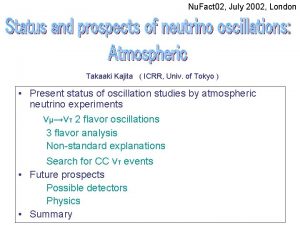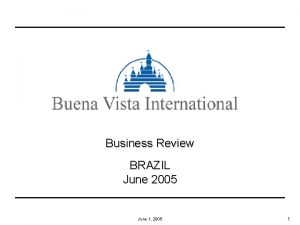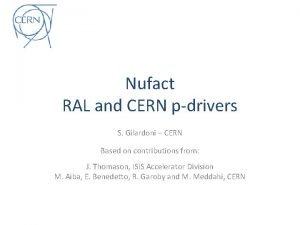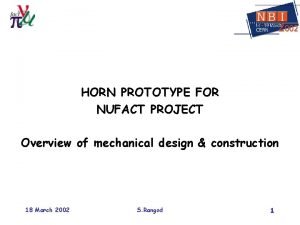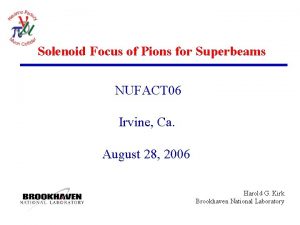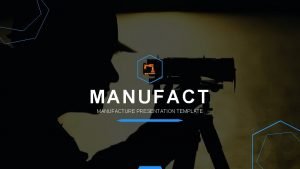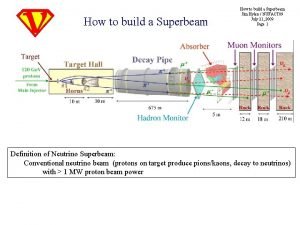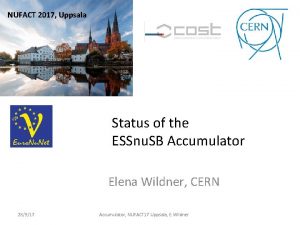Nufact 05 SI Capri June 2005 T Kajita









































- Slides: 41

Nufact 05 SI, Capri, June 2005 T. Kajita (ICRR, U. of Tokyo) • Introduction - why low energy detectors @Nu. Fact. SI ? • Solar neutrino detectors water Cherenkov detector (Super-Kamiokande) heavy water detector (SNO) • Detectors for reactor experiments (Kam. LAND) • Water Cherenkov atmospheric neutrino detector (Super-Kamiokande) • Low energy long baseline experiment - K 2 K • Summary


General requirement for low energy neutrino detectors n-nucleon interaction cross section CC total s/En s(n. N) is approximately proportional to En (for En > m. N) En(Ge. V) Cross section is small for low energy neutrinos Produced particles have low energy Particle tracking is difficult Large neutrino detector (Cheap neutrino detector) Typical solution: water Cherenkov or scintillator detectors

Neutrino masses and mixing angles –present and future Present: Study of dominant oscillation channels Future: Study of sub-dominant oscillations Known: q 12, Dm 122 n 3 ne nm nt q 23, |Dm 232| Unknown: q 13 Sign of Dm 232 or n 2 n 1 Solar n, Atmospheric n Kam. LAND Long baseline CP ? Future neutrino oscillation exp’s

Future neutrino experiments - example J-PARC BNL Fermilab Nu. MI b-beam Megawatt class super (or b)-beam + Megaton class water detector MEMPHYS UNO Hyper-K

Many other interesting low energy neutrino physics Low energy neutrino detectors


Solar neutrino flux and solar neutrino experiments Radio chemical experiments: detect 37 Ar, 71 Ge …. . Cherenkov detectors: detect (mainly) electrons http: //www. sns. ias. edu/~jnb/

Water Cherenkov detector (Super-Kamiokande) Water has p, O and ene+p : quantum number (ne+p e-+X++, but no X++) ne+16 O : energy (En < 14 Me. V) ne(nm, nt) +e-→ ne(nm, nt) +e- En Ee

More on n-e scattering ne e- W e- n ne e- ds/d. T for 10 Me. V neutrino n ee - nm(t) e- n Z e- s(nee) is (6 – 7) times higher than s(nm(t)e)

Detecting Cherenkov photons Number of Ch. photons with λ=300600 nm emitted by a relativistic particle per cm = 340. Need an efficient detection of the photons. Large PMTs electron Photomultiplier tube (PMT) ν 20 cm φ (SNO) n (refractive index)=1. 34 in water θ=42 deg. for β=1 50 cm φ (Super-K)

Super-Kamiokande 11, 146×(50 cm f PMT) : Inner detector 40% photo-cathode coverage Number of observed Ch photons ~ 6 /Me. V (excluding scattered or reflected photons) 1, 885×(20 cm f PMT) : Outer detector (Less photo-cathode coverage: Only needed to identify muons) 50, 000 ton water Cherenkov detector (Fid. Mass is 22, 500 tons) 2 m active detector region + 0. 6 m layer (no photon detection) γ (and neutron) shield

Super-Kamiokande detector under construction Summer 1995

Super-Kamioakande detector Jan. 1996

Detecting Cherenkov photons and event reconstruction electron PMT n Color: timing Time: vertex position Multiple Coulomb scattering direction Pulse height (number of pe’s): energy Size: pulse height

Detector calibration by an electron LINAC Precise calibration of absolute energy scale, energy resolution, and angular resolution using electron LINAC. ENDCAP 0. 1 mm thick Ti window • Beam energy: 5 ~ 16 Me. V/c • Beam energy spread: < 0. 5 %

Absolute energy calibration by LINAC Systematic error in the absolute energy scale : 0. 64 %. Data MC

16 N calibration Data taken at various positions in the detector. Uniform direction complementary to LINAC calibration. DT generator D+T→He+n (14. 2 Me. V) 106 n/pulse ~1% of n creates 16 N n+16 O→p+16 N decay (precisely known): 6. 129 Me. Vg + 4. 29 Me. Vb (66. 2%), 10. 419 Me. V b(28. 0%), etc.

16 N calibration data Direction dependence of the energy scale Energy spectrum (MC-DATA) / DATA Azimuthal angle ± 0. 5% Zenith angle ± 0. 5%

Solar neutrino data from Super-K May 31, 1996 – July 13, 2001 (1496 days ) n + e- n + e 5 -14 Me. V 0. 5 Me. V/c 2 background Assuming ne only: 8 B 22400 230 solar n events (14. 5 ev/day) flux : 2. 35 0. 02(stat) 0. 08(syst) Data SSM(BP 2000) = 0. 465 [x 106 /cm 2/sec] +0. 016 0. 005 -0. 015 ( Data/SSM(BP 2004) = 0. 406 0. 004 +0. 014/-0. 013 )

Remarks on background Old SK data Background: mainly Rn (214 Bi b decay) (Need a very clean water) Background above 6 Me. V: mainly events produced by cosmic ray muon interactions (m+16 O → m+ X, m X→Y+b+n) b (Need to cut events by time and space correlation with m. )

Electron energy spectrum and Day-night flux asymmetry Small mixing angle solution (SMA) +1. 3 Vacuum osc. solution Large mixing angle solution (LMA) ADN=-1. 8 1. 6 -1. 2 %

Allowed oscillation parameter region from M. Smy, et al. , Phys. Rev. D the SK data 69 (2004) 011104

SNO (1 kton D 2 O solar neutrino detector)

Sudbury Neutrino Observatory 1000 tonnes D 2 O Support Structure for 9500 PMTs, 60% coverage 12 m Diameter Acrylic Vessel 1700 tonnes Inner Shielding H 2 O 5300 tonnes Outer Shield H 2 O

SNO detector under construction

n Reactions in SNO ES - Þ + + νx e -Strong directional sensitivity - Mainly sensitive to ne, , less to n and n Any other interactions? (“d” is a very weakly bound p+n system)

n Reactions in SNO (2) CC n e + d Þ p + e. Eth=1. 4 Me. V - Weak directional sensitivity 1 -1/3 cos(q) - ne ONLY NC n x + d Þ p + n +n x Eth=2. 2 Me. V - Measure total 8 B n flux from the sun. - Equal cross section for all n types How can SNO measure NC interactions?

Three ways to measure the NC events Neutron Detection Method (1) Pure D 2 O n+ d n + p + n n d t g (Eg = 6. 3 Me. V) (g produces e by Compton scattering) (2) D 2 O with salt n 35 Cl 36 Cl g’s (S(Eg) = 8. 6 Me. V) ( Competing process: n+d t+g ) Na. Cl 2 tons

Three ways to measure the NC events (3) Neutron counters in D 2 O n 3 He p t Measure the energy deposit of these particles in the counter n 3 He p t Event by event separation of CC and NC

Signal extraction: Monte Carlo Simulation (pure D 2 O phase) Radial Response n d t g … e (Eg = 6. 25 Me. V) D 2 O Energy Direction from the Sun H 2 O NC

Background Old SK data Background: mainly Rn (214 Bi β decay) Need very clean D 2 O Background above 6 Me. V: mainly events produced by cosmic ray muon interactions (μ+16 O → μ+ X, X→Y+β+ν) Need to go deep Super-K=1 km, SNO=2 km

#EVENTS SNO Results (pure D 2 O) CC 1967. 7 +61. 9 +60. 9 ES 263. 6 +26. 4 +25. 6 NC 576. 5 +49. 5 +48. 9

Main SNO result (2002, pure D 2 O phase) Evidence for solar neutrino oscillation

SNO salt phase 2 tons of Na. Cl added into 1000 ton D 2 O (Salt phase: 2001 -2003) NC nx +d → p + n +n x X 0. 45 X 1/3 n Cl g‘s (SEg = 8. 6 Me. V) NC (salt) - Equal cross section for all n types ◆Higher neutron capture rate ◆Higher total energy release NC (Pure D 2 O) ~ 9 NHIT/MEV

Results from SNO salt phase Nucl-ex/0502021 Salt phase Pure D 2 O phase 391 days NC CC More accurate total flux (=ne+nm+nt) measurement

Allowed parameter region SNO only SMA All solar n exps LMA solution LOW SMA solution excluded Both LMA and LOW are allowed. LMA solution only.

Any other application of salt in future neutrino experiments? GADZOOKS! M. Vagins, J. Beacom hep-ph/0309300 ne + p e+ + n n + Gd + g’s S(Eg) = 8 Me. V g’s ~(a few)× 10 s 0. 2% Gd. Cl 3 >90% capture efficiency Coincidence of e+ and g reduces the BG significantly Relic supernova neutrinos Reactor neutrinos, …. .

End (Summary: after one more lecture)

Trigger threshold of Super-K 6. 5 Me. V LE analysis (May ‘ 96~)) 5. 5 Me. V SLE trigger (4. 7 Me. V@50%) SLE-V 2 trigger (4. 2 Me. V@50%) (550 Hz) SLE analysis (May ‘ 97~) 5. 0 Me. V SLE-V 2 analysis LE trigger (5. 7 Me. V@50%) (10 Hz) Ee (Me. V) Since July 2000, further lowered by 12% (SLE-version 3). (100 % eff. for >4. 5 Me. V, 3. 7 Me. V@50%)

6. 13 Me. V SNO Energy Calibration 19. 8 Me. V CC solar ν(MC) 252 Cf b’s from 8 Li g’s from 16 N and t(p, g)4 He neutrons
 Nufact
Nufact Puma capri para
Puma capri para Capri spring school
Capri spring school Capri model
Capri model June 2005 calendar
June 2005 calendar Nasa june 19 2008
Nasa june 19 2008 Spanish flacs exam 2018 answers
Spanish flacs exam 2018 answers Cxccxc results 2018
Cxccxc results 2018 Lake june head start
Lake june head start June 23
June 23 Rizal hereditary influence
Rizal hereditary influence Flacs exam 2020
Flacs exam 2020 German cartoon 1919 treaty of versailles
German cartoon 1919 treaty of versailles Foreshadowing in the lottery
Foreshadowing in the lottery Foreshadowing in the lottery
Foreshadowing in the lottery Good morning welcome june
Good morning welcome june Holy june
Holy june June 15 1215
June 15 1215 Dr june carroll
Dr june carroll Grade 7 life orientation term 1 notes
Grade 7 life orientation term 1 notes Elephant riding in phuket resuelto
Elephant riding in phuket resuelto Chemistry regents january 2018 answers
Chemistry regents january 2018 answers June 2007 physics regents
June 2007 physics regents Britney spears biography
Britney spears biography Dr june james
Dr june james June ward
June ward February march april may june july
February march april may june july June 22 to july 22
June 22 to july 22 Danswer
Danswer Summary period: june 2021 poem
Summary period: june 2021 poem June canavan foundation
June canavan foundation Companies in june
Companies in june June 2019 geometry regents answers
June 2019 geometry regents answers June f
June f June preschool newsletter
June preschool newsletter June too soon july stand by
June too soon july stand by New irpwm june 2020
New irpwm june 2020 Mitsl
Mitsl June's journey
June's journey 2019 june calendar
2019 june calendar Lenore hetrick photo
Lenore hetrick photo Network weaver
Network weaver
